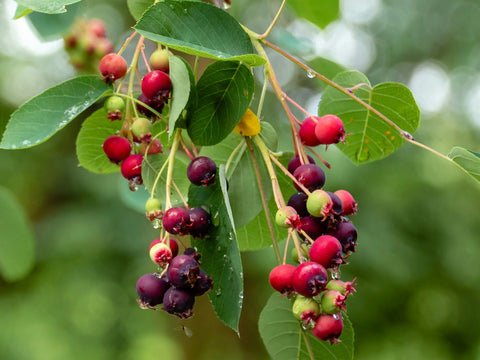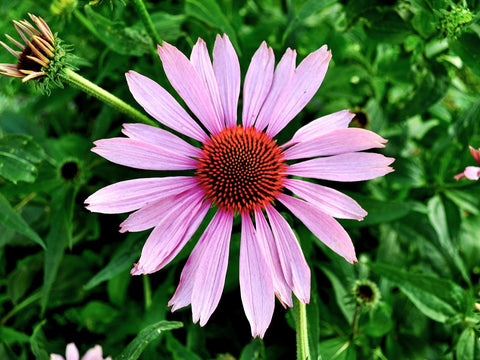Syrups for Cold and Flus!

That time is near again! The cold winter-ey months, bringing on those cold and flu viruses in full force! This is the time of year we pull out our warm wool clothing, dressing in layers, drinking hot beverages AND when our immune systems need the most support! Luckily we have warming herbal remedies that can assist with this!
Starting with Herbal Syrups!
Who doesn’t love a sweet syrup on your pancakes, waffles, in your tea or coffee?
Amazingly enough, you can use herbal syrups in these ways (keep reading to find out how) along with taking it by the spoonful, to keep those viruses away! Not only do they taste amazing! While making them, they warm up your home, leaving an amazing herbal smell! Just thinking about herbal syrups makes me feel all warm and cozy. Bringing back the memories of last winter, sitting all curled up with a blanket, reading a book, while sipping on a tea sweeten with syrup. Yummmm! And what better herb to use for syrups than Elderberries!
Their rich purple color, sweet-earthy flavor and immune system support are the perfect combination!
The recipe today includes Elderberries with Echinacea! Another strong immune herb! Giving you an ultra immune support syrup!
This information and recipes are from a *free* DIY Kitchen Herbal Remedy workshop, I presented!
I wanted to make a post about it for all who couldn’t make it. And for those who did make it and wanted more herbal recipes!
More workshops in the future. Plus I’m planning to create online content as soon as possible. So stay tuned for that!
Without further a do, here are:
- Herbs that make delicious syrups
- How they help with colds and flus
- How to grow 2 of the herbs in the featured recipe, in your own backyard
- The Art of Making Syrups
Herbs that make delicious syrups for Colds and Flus
In our featured recipe we have elderberry and echinacea.- Being researched and was traditionally used for:
- Supporting the respiratory system, soothe inflammation
- Diaphoretics: inducing sweat to flush out that icky sickness and feeling
- Rich in vitamin C
- Immune-enhancing and antiviral properties. Even more effective when combined with echinacea
- Best taken at first subtle signs of symptoms. Before the virus takes hold
- Nice daily preventative tonic during winter months
- Immune- enhancing, antimicrobial, antiviral, anti-inflammatory. And lymphatic properties, helping to clear out the lymph nodes during times of sickness
- Useful for sore throats
- Recent reports are noting limiting its usage for no more then 2 weeks, to optimally work and not negatively effect the body in other ways. Taking breaks from herbs can help your body to maximize its potential. And echinacea its definitely a good immune herb to use at times when you feel your immune system is not living to its fullest potential
- Thyme leaf (Thymus vulgaris) antibacterial, antiviral, antispasmodic, expectorant. Helps liquefy and clear congestion in sinus and lungs
- Elecampane root (Inula helenium): anti inflammatory, soothing, use for wet coughs, expel mucus
- Marshmallow root (Althaea officinalis) soothing for dry hoarse cough, sore throats, respiratory inflammation
- Chamomile flower (Anthemis nobilis and related species): anti bacterial, anti-catarrh, antispasmodic, anti-inflammatory
- Peppermint leaf (mentha x piperita): antibacterial, antiviral, anti inflammatory and antispasmodic properties
- Juniper berries (juniperus communis) anti septic, anti bactierial, anti viral, expectorant
 |
 |
How the 2 featured herbs grow
- 2 species commonly used that grow here: Sambucus Canadensis (native North America) and Sambucus nigra (native to Europe)
- Only species of elder with blue-black berries are edible. Red elderberries are NOT
- S. Canadensis commonly called American Black Elder
- Tolerates a wide range of soils, but prefers med-wet well drained soil
- Full sun to part shade
- Once established, it grows quickly and can reach up to 12 feet. Making it a beautiful edible shrub. If you want vast quantities of elderberries, must fertilize the soil at planting with manure or compost
- Creates tiny lemon-scented clustered white flowers. That attracts birds and butterfly's
- Late summer flowers give way to clusters of deep purple-black elderberry fruits on violet stems. Attracts birds, deer and other wildlife, be sure to protect the berries
- Harvest: mid-August to mid-September, check almost daily. Ripe when deep purple-black in color with a plump appearance, and much heavier than unripe clusters, tending to hang upside down
- Once harvested you should within 12 hours cook them or freeze them. They will start to ferment and go bad if left for more then 12 hours in the fridge
- Never harvest elderberry fruits that are not completely ripened. The immature fruits are poisonous and can cause nausea. For the same reason, it's advised to cook the ripe berries and don't consume them raw. Can cause vomiting, diarrhea, upset stomach
- Also know as purple cone flower. Native to North American plant. Medicinal Echinacea was used for years in traditional medicine by indigenous Americans
- Species Echinacea. Augustifolia and Echinacea purpurea is native to North American prairies and open meadows
- Major difference is their roots. Augustifolia fibrous. Purpurea tap, thin roots
- Flowering perennial (come back year after year
- Sun Exposure: Full sun or part shade
- Soil Type: Normal, sandy, or clay
- Water them daily just after planting, then transition to twice weekly or even once weekly, depending on the climate. Second-year and older plants may need very little watering
- Deadheading is the primary maintenance required. Removing the dead flowers from living plants will keep them in bloom all summer. Each flower remains in bloom for several weeks
- The aerial parts are most often used for herbal teas, while the roots hold the most powerful properties from the plant
- Harvest the roots of a 2-3-year-old plant in the spring or the fall
- Echinacea is an endangered plant, so growing or buying your own Echinacea is preferred to harvesting from the wild

Art of Making Syrups
Basic Ratio Guideline- 1/2 cup - 1 cup plant
- 1/2 cup - 1 cup plant to 4 cup water
- You can use various plants in a syrup recipe equally to 1/2 - 1 cup per 4 cup of water. Considering how many herbs you want to use, could add 1/4 teaspoon- 2 tablespoons (or more) of each herb to equal 1/2 - 1 cup
- The ratios of each herb would depend on taste, medicinal action you want and recommended ratios for the specific herb your using
- Decoct herbs, reducing liquid by about half
- Add 1 - 2 cup honey
- Store in glass jar in the refrigerator for up to 2-8 weeks. Using a 1:1 ratio (1 part honey to 1 part liquid) can even make it last up to 6 months in fridge. More honey used longer it lasts, as it acts as a natural preservative
- Enjoy a teaspoon daily. Or up to a tablespoon, especially when fighting cold and flu symptoms
-
Place the water and herbs into a medium pan
-
Heat over medium heat until slightly boiling
-
Reduce heat and cover
-
Simmer on low heat for 20-40 mins, stirring occasionally, reducing the liquid by about half
-
Remove from heat and allow to cool at room temperature for 10 minutes
-
Strain
-
Discard the contents left in the strainer
-
Cool the liquid for an additional 15 minutes at room temperature
-
Add the honey and stir well
-
Store in the fridge
-
If you want thicker syrup, add the honey then cook for 20 minutes longer over high heat. Though this will cook the living enzymes out of the honey and it will no longer act like a natural preservative
-
Place water, and herbs in pot
-
Place your Instant Pot on Manual High pressure for 7 minutes
-
Do a quick release
-
Strain with a mesh strainer into a bowl and press herbs to release all juices
-
Let cool about 10-15 minutes
-
Stir in Honey
-
Transfer to a mason jar with a lid and store in the refrigerator

Recipe
- 1/2 c. dried elderberries
- 2 Tbsp dried echinacea root (Optional. Use periodically. Not recommended for children under 12*)
- 4 c. distilled water to start. Reducing by half to 2 cup at end
- 1-2 c. raw honey
* To make recipe child-friendly omit it or consult with health care practitioner before use.
Ratio Recipes for other Suggested Herbs
- Thyme: earthy, slightly sweet, mildly mint flavor. 1 cup to 4 cup water
- Elecampane root: Bitter, Pungent flavor. Due to taste best to use 1/4 cup per 4 cup water. Pair with 1/4 cup rosehips, for a pungent tangy flavor
- Marshmallow root: Earthy flavor. 1 cup per 4 cup water
- Chamomile flower: Mild apple like flavor, hint of bitter. Use 1/4 - 1/2 cup per 4 cup water
- Peppermint leaf: Well known spicy mint flavor ! 1/2 cup or more to 4 cup water
- Juniper berries: Very bitter flavor (similar to a gin and tonic). 2 tablespoons to 4 cup water. Pair with 1/2 - 1 cup of elderberry or rosehips (or a 1/2 cup of both), for a tart, slightly sweet flavor
- When using herbal remedies: If your cold or flu is getting worse or not significantly better within a few days or any negative reaction occurs, discontinue use and consult a health care practitioner
- If taking medications, other herbal or non-herbal supplements, or if pregnant or breastfeeding always check with a health care practitioner before use
- Syrups not recommended for under 2 years old due to honey

Other ways to use herbal syrups
As I mentioned earlier, pancakes, waffles, toast, tea, and coffee. Even desserts, bubbly beverages, and cocktails, are all situations that call for Syrups! Without overdoing it on the Herbal Syrup, adding a tablespoon of the syrup to any of these (or other ideas you can think of) would be a great balance of a sweetener with immune-boosting support!
You could also freeze the syrup by putting it into ice cup trays!
Adding a tablespoon or less into each cube, for a way to preserve the syrups longer. Can plop it into your hot tea! Or turn them into Popsicle by inserting sticks into the cubes.
Enjoy and have fun making Herbal Syrups!
May the herbs make your sick less often or not at all, this winter season!

